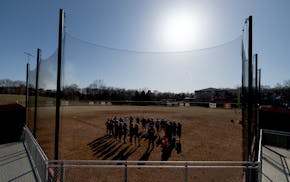Minnesotans serving people with addiction say the state's $10 million plan for safe recovery sites is a major step to keep people who use drugs alive and connect them with services. But they fear the dollars could be pulled away.
The sites would offer sterile syringes and safer supplies for smoking and snorting, overdose reversal kits and education on how to use them, as well as test strips to check if a substance is laced with other drugs, like fentanyl and xylazine.
Visitors could also get the basics, like a restroom, hygiene kit, shower and place to do laundry. There would be education on safer use, links to care and referrals to other services. The sites would do syringe cleanup and street outreach in their neighborhoods.
"Creating spaces like this saves people's lives, provides education and connects people to services and just leads to better health outcomes," said Jack Martin, executive director of Southside Harm Reduction Services in Minneapolis. "We all deserve safety."
The state recently posted its request for providers to apply for the grant dollars that were approved nearly two years ago. It's the latest step in Minnesota's evolution on harm reduction services and policies, which aim to prevent illness and death among people who aren't abstaining from drug use.
Nationally, medical associations and people who use drugs say the approach saves lives. But it remains controversial. As state leaders roll out safe recovery site dollars they held off on a significant piece of the original plan: Supervised consumption sites, where people take illegal drugs in a sterile, monitored environment.
Minnesota is one of the few states to approve the creation of such facilities. Other countries, including Canada, use them. But they remain rare in the United States. During his previous term, President Donald Trump's administration fought to prevent a supervised injection site from opening in Philadelphia.
It's not just the specter of federal action that has Minnesota providers on edge.
The state Senate's proposed Human Services budget bill would cancel the safe recovery site grants. The House and Gov. Tim Walz have not proposed the cut.
With a looming deficit, every program's budget is being tightened, Senate Human Services Committee Chair John Hoffman, DFL-Champlin, said in a statement, noting that their targeted human services cuts are about half what the House and governor suggested.
"We are still forced to make difficult decisions," Hoffman said. "We are focused on preserving those core services that help those who need it most."
Minnesota's evolution
Minnesota has a storied history in addressing addiction. About 75 years ago the Hazelden Foundation started with a concept that came to be known as the "Minnesota Model." A core tenant was participants needed to stay sober.
Over the years, as substance use and responses have changed nationally, more models have taken root. People working in the field said in recent years there have been substantial changes in state law — and public attitudes — to support people who aren't sober.
Curtis Jackson, an inpatient treatment center program manager in Cass Lake, said he's seen his northern Minnesota community increasingly back harm reduction. Jackson is in long-term recovery and said that while complete abstinence worked for him, there is no cookie cutter path through addiction. He tries to use harm reduction practices to help his twin brother, an active user.
"There's a lot more acceptance. There is less desire or need to operate undercover," said Mary McCarthy, executive director of the Rural AIDS Action Network.
Harm reduction emerged decades ago in response to the HIV/AIDS crisis, she said, noting the main purpose "is to keep people alive and breathing and healthy, because dead people don't recover."
Many policy changes came as former President Joe Biden made harm reduction a key piece of his drug strategy, a move that met some pushback, particularly around funds for safer use supplies.
In 2023, Minnesota lawmakers not only legalized marijuana, they removed penalties for possessing or delivering drug paraphernalia, from syringes to pipes to bongs, including items that had drug residue of any sort on them.
Legislators also clarified that providers are allowed to give out syringes and that materials used to detect what's in a drug, like fentanyl test strips, are legal. Minnesota followed Rhode Island in becoming the second state to allow safe injection spaces.
That year lawmakers devoted about $18 million to safe recovery sites. Safe injection spaces were the first item on a list of services to offer there.
Future of use sites
While supervised use spaces won't initially be part of sites, the Department of Human Services is committed to implementing them in the future, said Teresa Steinmetz, assistant commissioner of DHS's behavioral health administration.
"There's still a lot of work that needs to be done before the service can be supported throughout the state," she said. "Part of that is really engaging with communities, engaging federal partners [and] local law enforcement to determine the best steps to move forward."
Some of that work has been happening over the past couple years, she said. State staff visited OnPoint NYC — which runs two supervised use sites — and talked with New York City's health department and a local syringe service program there in January 2024, she said. They also met with staff in Rhode Island's Health and Human Services Office about a program in the works there.
Officials have talked with local partners, Steinmetz said, including 13 programs that deliver sterile syringes and other safety supplies and drug testing equipment to people actively using. She noted researchers found new users of such programs are five times more likely to go into treatment and roughly three times more likely stop using drugs.
Their key takeaway was community engagement is critical before and after the creation of supervised consumption sites, she said. Steinmetz said DHS will work with safe recovery site grantees to hold community conversations about supervised use.
Safe recovery sites will be a tremendous help for providers to connect with people, help keep them safe and offer resources when they are ready for change, said Charles Hilger, chief operating officer for White Earth Nation's urban behavioral health programs.
"Sometimes just having that support person around can be the reason that they choose to make the change," Hilger said. "The No. 1 predictor of success in recovery is support."
He and other providers want to see safe consumption sites added. But several people stressed that needs to happen thoughtfully with the support of the city where they will be located.
While Minnesota law allows the sites, the state has to ensure the federal government is at least "passively agreeable" and won't shut things down, Hilger said.
"Let's face it, it's already going on all over the place," he said, noting one of the most "prolific" use sites are Hennepin County library bathrooms. "If they are going to use, might as well have them be safe."
Reducing deaths
Anything Helps, a nonprofit that runs a drop-in center in north Minneapolis and has a syringe service program, plans to seek safe recovery site funds.
The state's request for proposals, posted this month, would give a total of $10 million to four to six sites. Contracts are expected to last from this July 1 through June 2029, and can be extended.
The sites could help address Minnesota's racial disparities in overdose deaths, Anything Helps Executive Director Emanuel Roberts said.
Preliminary state Health Department data from 2023 showed the first dip in fatal overdoses in five years, mirroring a national drop. The harm reduction strategy of distributing overdose-reversing naloxone was likely part of the reason, many experts said. But state officials said the decline was primarily confined among white residents.
Native Americans have been dying from overdoses at more than nine times the rate of white Minnesotans and Black Minnesotans have been dying at more than three times the rate of white residents, according to the Health Department.
"People who are in currently in that survival mode, they are part of our community, part of our neighborhood and they need places to go where they feel comfortable and safe," Roberts said. "Some people's journey isn't sobriety right away."

Golden Valley highway crash leaves one man dead; suspect in custody
Semi kills 10 cows on southeastern Minnesota highway
In South Carolina, Walz says Democrats 'need to change the attitude'
Two injured in shooting outside University of Minnesota arena after high school graduation

